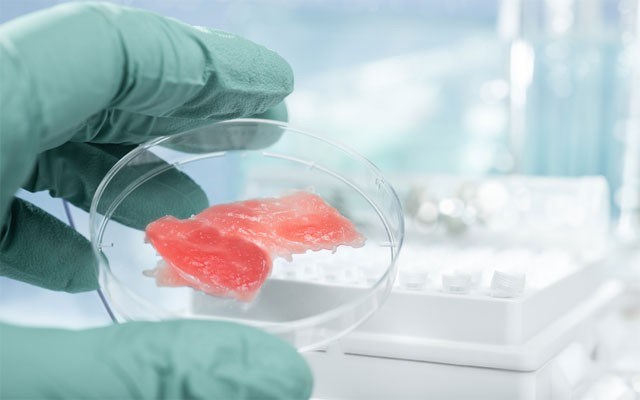The most important hamburger in the history of the world was cooked (but only half-eaten) in London on Monday. It was grown in a lab, not cut from a cow, and it tasted — well, not quite good enough to fool the experts, but then they forgot the ketchup, mustard, cheese, onion, bacon, tomato and lettuce. Not to mention the fries.
"I miss the fat, there's a leanness to it," said food writer Josh Schonwald, "but the general bite feels like a hamburger." Austrian food critic Hanni Ruetzler agreed: "It's not that juicy, but the consistency is perfect. This is meat to me. It's not falling apart; it's really something to bite on." Even in a blind tasting, she added, she would say that it was real meat and not a soya copy.
Of course she would. It WAS real meat, grown from a cow's stem cells just like the flesh of its own body. It tasted lean because the stem cells the experimenters used were only programmed to make muscle tissue, not fat. (They're working on that). The real test was whether tens of billions of lab-grown muscle cells could be organized into something with the consistency of proper meat, not mush, and the lab-burger passed that test with flying colours.
But why would anybody want to pass that test? What's wrong with just eating cows — and sheep and pigs and chickens? Far beyond the objections of vegetarians and animal-rights activists, what's wrong with eating "natural" meat is that there are too many of us, eating too much of it, and we're running out of land to grow it on.
"Right now, we are using 70 per cent of all our agricultural capacity to grow meat through livestock," Professor Mark Post, the lead researcher, told The Independent at a conference in Vancouver last year. "You are going to need alternatives. If we don't do anything, meat will become a luxury food and will become very expensive...."
"Livestock also contributes a lot to greenhouse gas emissions, more so than our entire transport system," explained Post, a medical physiologist at Maastricht University in the Netherlands. "Livestock produces 39 per cent of global methane, five per cent of the CO2, and 40 per cent of the nitrous oxide. Eventually, we will have an eco-tax on meat." On meat raised in the open air, that is.
Whereas meat grown in the lab is a potentially inexhaustible resource, and it does far less environmental damage. According to an Oxford University study published in 2011, a tonne of "cultured" beef would require 99 per cent less land and between 82 and 96 per cent less water than its "natural" rival, and would produce between 78 and 95 per cent less greenhouse gas. It would also use 45 per cent less energy.
These are seriously impressive numbers. If Post's process can scale up successfully, then in ten or twenty years we could be producing enough meat for a growing global population even though many people are eating more meat per capita as their incomes rise. Moreover, we would be able to turn most of that 70 per cent of agricultural land back into forest and prairie, or switch it to growing grain for human consumption.
"There are basically three things that can happen going forward," said Google co-founder Sergey Brin, who bankrolled Post's research. "One is that we can all become vegetarian. I don't think that's really likely. The second is we ignore the issues, and that leads to continued environmental harm. The third option is we do something new."
"Some people think this is science fiction, I actually think that's a good thing. If what you're doing is not seen by some people as science fiction, it's probably not transformative enough... We're trying to create the first cultured beef hamburger. From there I'm optimistic we can really scale (up) by leaps and bounds."
You probably can. Post's technique involves extracting stem cells from cow muscle tissue and growing them "in vitro" for three weeks, providing nutrients and growth-promoting chemicals. Then the mass of new cells is transferred to smaller dishes where they find themselves between two electrodes — and self-organize into strips of muscle tissue.
Then you give the new muscle tissue some exercise (to bulk it up) by applying small shocks that make it contract. And then it's hamburger meat, ready to be cooked. Growing an actual steak would be more complex, but in theory it could be done by getting the strips of muscle tissue to take shape on a biodegradable lattice that includes artificial blood vessels to deliver nutrients and oxygen to the interior of the steak.
So let's assume that you can produce this beef in industrial quantities, complete with fat cells so that it tastes just like the meat that comes from the slaughterhouse. Could you get people to buy it?
No problem. Just price it about 20 per cent cheaper than the "real thing." Those of us who are keeping up with the Joneses will buy the premium product; the rest of us will buy the one that's just as good but costs less.
Oh, and why didn't they eat the whole hamburger on Monday? Because there was no way that you could share out what was left equally between so many journalists, and they sometimes get quite nasty if they're thwarted. So Mark Post said he'd take it home to his children.
Gwynne Dyer is an independent journalist whose articles are published in 45 countries.




